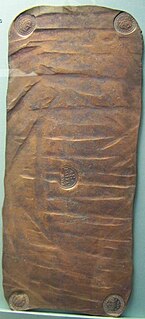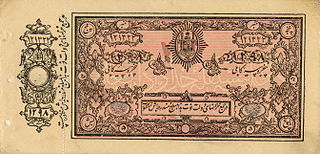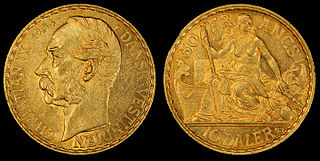
The rigsdaler was the currency of Greenland until 1874. It was equal to the Danish rigsdaler which circulated in Greenland alongside distinct banknotes from 1803.

The rigsdaler was the currency of Greenland until 1874. It was equal to the Danish rigsdaler which circulated in Greenland alongside distinct banknotes from 1803.
Before 1813, the rigsdaler courant was subdivided into 96 skilling. In 1813, the rigsdaler courant was replaced by the rigsbanksdaler at a rate of 6 rigsdaler courant = 1 rigsbanksdaler, with the rigsbanksdaler subdivided into 96 rigsbank skilling. In 1854, the names were changed to the rigsdaler and skilling rigsmønt. In 1874, the kroner was introduced, at a rate of 2 kroner = 1 rigsdaler. See Danish rigsdaler for a more detailed history.
In 1803, the Kongelige grønlandske Handel introduced notes in denominations of 12 and 24 skilling, 1⁄2 and 1 rigsdaler courant. The next year, the Handelsstederne i Grønland took over the issuance of paper money and introduced notes for 6 and 12 skilling, 1⁄4, 1⁄2, 1 and 5 rigsdaler courant.
In 1819, following the currency reform, notes were introduced in denominations of 6, 12 and 24 skilling and 1 rigsbankdaler. These were replaced in 1856 by notes for the same amounts but in the new denominations of skilling rigsmønt and rigsdaler.

The svenska riksdaler was the name of a Swedish coin first minted in 1604. Between 1777 and 1873, it was the currency of Sweden. The daler, like the dollar, was named after the German Thaler. The similarly named Reichsthaler, rijksdaalder, and rigsdaler were used in Germany and Austria-Hungary, the Netherlands, and Denmark-Norway, respectively. Riksdaler is still used as a colloquial term for Sweden's modern-day currency.

The krone is the official currency of Denmark, Greenland, and the Faroe Islands, introduced on 1 January 1875. Both the ISO code "DKK" and currency sign "kr." are in common use; the former precedes the value, the latter in some contexts follows it. The currency is sometimes referred to as the Danish crown in English, since krone literally means crown. Historically, krone coins have been minted in Denmark since the 17th century.
The króna is the currency of the Faroe Islands. It is issued by Danmarks Nationalbank, the central bank of Denmark. It is not a separate currency, but is rather a local issue of banknotes denominated in the Danish krone, although Danish-issued coins are still used. Consequently, it does not have an ISO 4217 currency code and instead shares that of the Danish krone, DKK. The króna is subdivided into 100 oyru(r).

The rigsdaler was the name of several currencies used in Denmark until 1875. The similarly named Reichsthaler, riksdaler and rijksdaalder were used in Germany and Austria-Hungary, Sweden and the Netherlands, respectively. These currencies were often anglicized as rix-dollar or rixdollar.
The peso was the currency of Paraguay between 1856 and 1944. It replaced the real at a rate of 8 reales = 1 peso. Until 1870, the peso was subdivided into 8 reales. Paraguay then decimalized, with 100 centésimos = 1 peso. The name of the subdivision was changed to centavo in 1874. The peso was replaced in 1944 by the guaraní at a rate of one hundred to one.

The hwan was the currency of the Republic of Korea between February 15, 1953 and June 9, 1962.

The peso was the currency of Costa Rica between 1850 and 1896. It was initially subdivided into 8 reales and circulated alongside the earlier currency, the real, until 1864, when Costa Rica decimalized and the peso was subdivided into 100 centavos. The peso was replaced by the colón at par in 1896

The peso was the currency of Nicaragua between 1878 and 1912. It was Nicaragua's first national currency, replacing the Central American Republic real and that of neighbouring states. It was subdivided into 100 centavos and when it was introduced, it was worth 8 reales, and had the same weight and mass as the peso fuerte, but due to recurrent devaluations, it was replaced by the córdoba at a rate of 12½ pesos = 1 peso fuerte = 1 córdoba.
The Nigerian pound was the currency of Nigeria between 1907 and 1973. Until 1958, Nigeria used the British West African pound, after which it issued its own currency. The pound was subdivided into 20 shillings, each of 12 pence. The Nigerian pound was replaced with the introduction in 1973 of the decimal naira at a rate of £N1 = ₦2. This made Nigeria the last country to abandon the £sd currency system.

The rixdollar was the currency of British Ceylon until 1828. It was subdivided into 48 stivers, each of 4 duit. Units called the fanam and larin were also used, worth 4 and 9½ stiver, respectively. The currency derived from the Dutch rijksdaalder and stuiver, although the rijksdaalder was worth 50 stuiver. The rixdollar was replaced by the British pound at a rate of 1 rixdollar = 1 shilling 6 pence.

The escudo was the currency of Portuguese Timor between 1959 and 1976. It replaced the pataca at a rate of 5.6 escudos = 1 pataca and was equivalent to the Portuguese escudo. It was replaced by the Indonesian rupiah following East Timor's occupation by Indonesia. The escudo was subdivided into 100 centavos.
The pound was the currency of Southern Rhodesia. It also circulated in Northern Rhodesia and Nyasaland. The pound was subdivided into 20 shillings, each of 12 pence.

The Afghan rupee was the currency of Afghanistan until 1925. Before 1891, silver rupees circulated with copper falus and gold mohur. The three metals had no fixed exchange rate between them, with different regions issuing their own coins.

The peso was a currency of Ecuador until 1884.
The pound was the currency of Western Samoa between 1914 and 1967. It was subdivided into 20 shillings, each of 12 pence.

The daler was the currency of the Danish West Indies between 1849 and 1917, and of the United States Virgin Islands between 1917 and 1934.
The rigsdaler was the currency of the Danish West Indies until 1849. It was subdivided into 96 skilling. The rigsdaler was equal to 4⁄5 Danish rigsdaler. The rigsdaler was replaced by the daler.

The rigsdaler was the unit of currency used in Norway until 1816 and in Denmark until 1873. The similarly named Reichsthaler, riksdaler and rijksdaalder were used in Germany and Austria-Hungary, Sweden and the Netherlands, respectively.

The Greenlandic krone was a planned currency for Greenland, plans of which were abandoned in 2009. The same name is often used for currency issued during Greenland's time as a Danish colony. The name krone is derived from the Danish krone, introduced in an 1873 currency reform that replaced Danish mark and skilling.
The pound was the currency of Nova Scotia until 1860. It was subdivided into 20 shillings, each of 12 pence. It was equivalent to the British pound and was replaced by the dollar in 1860, at a rate of 5 dollars = 1 pound, although coins and notes of the dollar currency were not issued until 1861.